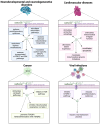Diverse Applications of the Anti-Diabetic Drug Metformin in Treating Human Disease
- PMID: 39770443
- PMCID: PMC11677501
- DOI: 10.3390/ph17121601
Diverse Applications of the Anti-Diabetic Drug Metformin in Treating Human Disease
Abstract
Metformin is a commonly used drug for treating type 2 diabetes. Metformin is an inexpensive drug with low/no side effects and is well tolerated in human patients of different ages. Recent therapeutic strategies for human disease have considered the benefits of drug repurposing. This includes the use of the anti-diabetic drug metformin. Accordingly, the anti-inflammatory, anti-cancer, anti-viral, neuroprotective, and cardioprotective potentials of metformin have deemed it a suitable candidate for treating a plethora of human diseases. As results from preclinical studies using cellular and animal model systems appear promising, clinical trials with metformin in the context of non-diabetes-related illnesses have been started. Here, we aim to provide a comprehensive overview of the therapeutic potential of metformin in different animal models of human disease and its suggested relationship to epigenetics and ailments with epigenetic components.
Keywords: drug repurposing; epigenetics; human disease; metformin; type 2 diabetes.
Conflict of interest statement
The authors declare no conflicts of interest.
Figures




Similar articles
-
Validating drug repurposing signals using electronic health records: a case study of metformin associated with reduced cancer mortality.J Am Med Inform Assoc. 2015 Jan;22(1):179-91. doi: 10.1136/amiajnl-2014-002649. Epub 2014 Jul 22. J Am Med Inform Assoc. 2015. PMID: 25053577 Free PMC article.
-
Repurposing Metformin for the Treatment of Atrial Fibrillation: Current Insights.Vasc Health Risk Manag. 2024 Jun 21;20:255-288. doi: 10.2147/VHRM.S391808. eCollection 2024. Vasc Health Risk Manag. 2024. PMID: 38919471 Free PMC article. Review.
-
Metformin in Oncology - How Far Is Its Repurposing as an Anticancer Drug?Klin Onkol. 2020 Spring;33(2):107-113. doi: 10.14735/amko2020107. Klin Onkol. 2020. PMID: 32303131 Review. English.
-
Metformin: Activation of 5' AMP-activated protein kinase and its emerging potential beyond anti-hyperglycemic action.Front Genet. 2022 Oct 31;13:1022739. doi: 10.3389/fgene.2022.1022739. eCollection 2022. Front Genet. 2022. PMID: 36386794 Free PMC article. Review.
-
Metformin: A Narrative Review of Its Potential Benefits for Cardiovascular Disease, Cancer and Dementia.Pharmaceuticals (Basel). 2022 Mar 4;15(3):312. doi: 10.3390/ph15030312. Pharmaceuticals (Basel). 2022. PMID: 35337110 Free PMC article. Review.
Cited by
-
Randomized, double-blind, placebo-controlled pilot study of metformin as an adjunctive therapy in Parkinson's disease.Front Pharmacol. 2025 May 2;16:1497261. doi: 10.3389/fphar.2025.1497261. eCollection 2025. Front Pharmacol. 2025. PMID: 40385486 Free PMC article.
-
Metformin Induces Apoptosis and Ferroptosis of Ovarian Cancer Cells Under Energy Stress Conditions.Cells. 2025 Feb 2;14(3):213. doi: 10.3390/cells14030213. Cells. 2025. PMID: 39937004 Free PMC article.
-
Exploring multifaceted roles of metformin in therapeutic applications, mechanistic insights, and innovations in drug delivery systems across biological contexts: a systematic review.Drug Deliv Transl Res. 2025 Jun 24. doi: 10.1007/s13346-025-01903-y. Online ahead of print. Drug Deliv Transl Res. 2025. PMID: 40555912
References
-
- World Health Organization . World Health Organization; Geneva, Switzerland: 2023. World Health Organization Model List of Essential Medicines—23rd List, 2023.
Publication types
Grants and funding
LinkOut - more resources
Full Text Sources
Research Materials

